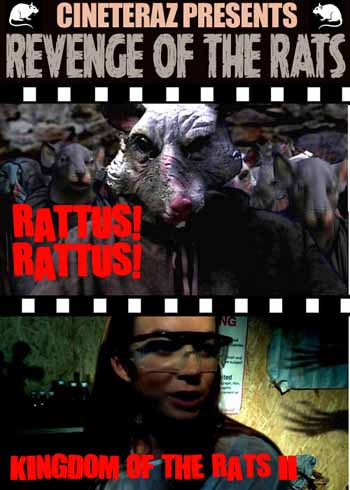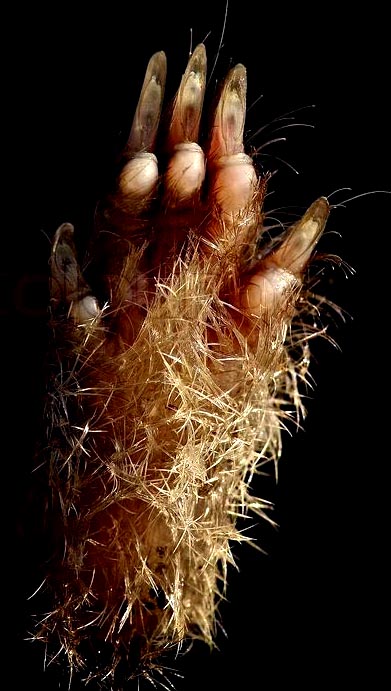

RAT FACTS
"Rattus norvegicus" and "Sewer Rat" redirect
here. For the album, see Rattus Norvegicus (album). For the roller
coaster, see Sewer Rat.
The brown rat (Rattus norvegicus), also known as the common
rat, street rat, sewer rat, wharf rat, Hanover rat, Norway rat
and Norwegian rat, is a widespread species of common rat. One
of the largest muroids, it is a brown or grey rodent with a body
length of up to 28 cm (11 in) long, and a tail slightly shorter
than that. It weighs between 140 and 500 g (4.9 and 17.6 oz).
Thought to have originated in northern China and neighbouring
areas, this rodent has now spread to all continents except Antarctica,
and is the dominant rat in Europe and much of North America.
With rare exceptions, the brown rat lives wherever humans live,
particularly in urban areas.
Selective breeding of the brown rat has produced the fancy
rat (rats kept as pets), as well as the laboratory rat (rats
used as model organisms in biological research). Both fancy rats
and laboratory rats are of the domesticated subspecies Rattus
norvegicus domestica. Studies of wild rats in New York City have
shown that populations living in different neighborhoods can
evolve distinct genomic profiles over time, by slowly accruing
different traits.
Naming and etymology
The brown rat was originally called the "Hanover rat"
by people wishing to link problems in 18th-century England with
the House of Hanover. It is not known for certain why the brown
rat is named Rattus norvegicus (Norwegian rat), as it did not
originate from Norway. However, the English naturalist John Berkenhout,
author of the 1769 book Outlines of the Natural History of Great
Britain, is most likely responsible for popularizing the misnomer.
Berkenhout gave the brown rat the binomial name Rattus norvegicus,
believing it had migrated to England from Norwegian ships in
1728.
By the early to the middle part of the 19th century, British
academics believed that the brown rat was not native to Norway,
hypothesizing (incorrectly) that it may have come from Ireland,
Gibraltar or across the English Channel with William the Conqueror.
As early as 1850, however, a new hypothesis of the rat's origins
was beginning to develop. The British novelist Charles Dickens
acknowledged this in his weekly journal, All the Year Round,
writing:
It is frequently called, in books and otherwise, the 'Norway
rat', and it is said to have been imported into this country
in a ship-load of timber from Norway. Against this hypothesis
stands the fact that when the brown rat had become common in
this country, it was unknown in Norway, although there was a
small animal like a rat, but really a lemming, which made its
home there.
Academics began to prefer this etymology of the brown rat
towards the end of the 19th century, as seen in the 1895 text
Natural History by American scholar Alfred Henry Miles:
The brown rat is the species common in England, and best known
throughout the world. It is said to have travelled from Persia
to England less than two hundred years ago and to have spread
from thence to other countries visited by English ships.
Though the assumptions surrounding this species' origins were
not yet the same as modern ones, by the 20th century, it was
believed among naturalists that the brown rat did not originate
in Norway, rather the species came from central Asia and (likely)
China
Diet:
The brown rat is a true omnivore and consumes almost anything,
but cereals form a substantial part of its diet. The most-liked
foods of brown rats include scrambled eggs, raw carrots, and
cooked corn kernels. The least-liked foods are raw beets, peaches
and raw celery. Foraging behavior is often population-specific,
and varies by environment and food source. Brown rats living
near a hatchery in West Virginia catch fingerling fish.Some colonies
along the banks of the Po River in Italy dive for mollusks, a
practice demonstrating social learning among members of this
species. Rats on the island of Norderoog in the North Sea stalk
and kill sparrows and ducks. |
 $14.95 $14.95
Kingdom Of The Rats II

VIDEO DOWNLOAD
[KOR2]
Story by Spider
Directed
by Richard Stalin
(This film is in 2 parts: Total Duration 24 mins)
Part One
and Part Two are sold together
VIDEO DOWNLOAD
Story by Spider
Starring Daphne Angel Cindy Doller Kathi Anderson Petr Sass
Adrzej Jass
(This film is in 2 parts: Total Duration 24 mins)
THE COMPLETE FILM PARTS 1 &
2
THIS FILM IS A SEQUEL TO THE
WORLWIDE BLOCKBUSTER
KINGDOM OF THE RATS
"Rattus norvegicus"
.jpg)
Professor Doller is working late in the laboratory when she is
interrupted by a surprise guest.
Her colleague has come to see her but she is proving too much
of a distraction for the
hard working professor and is asked to leave. Back to her task,
Cindy enacts some
nasty experiments on her caged rats that even Fauci would be
ashamed of.
The sadistic Professor enjoys her job so much that she does
not hear a new intruder at the door..... a very furry intruder....
But it seems that the little rats
have a more humanoid rat looking after them!
And now the murderous
Muroidea want revenge!
THE RAT CHAMBER
For her crimes against the Ratus Norvegicus she is kadnapped
and taken to a Secret Court.
But don't call it a Kangaroo Court but rodents are placental
mammals and
kangaroos are marsupials. The two are not even remotely related
despite
the fact that they occasionally resemble one another.
So best not to make the rats anymadder then they really are!
Well our hero be able to escape
her punishment or will they send her tp Room 101!?
"I SMELL A RAT!"
.jpg)
VIDEO SPECIFICATIONS
PART ONE
Duration: 11:11 Mins
File: MP4
Size: 139 Mb
Resolution:
720 x 576 (16/9)
Bit Rate: 1733 kbps
Frame
Rate: 29fps
Audio: 159 kbps (Stereo), 48Khz
|
PART TWO
Duration: 12:49 Mins
File: MP4
Size: 240 Mb
Resolution: 720 x 576 (16/9)
Bit Rate: 2613 kbps
Frame Rate:
25fps
Audio: 159 kbps (Stereo), 48Khz
|

|